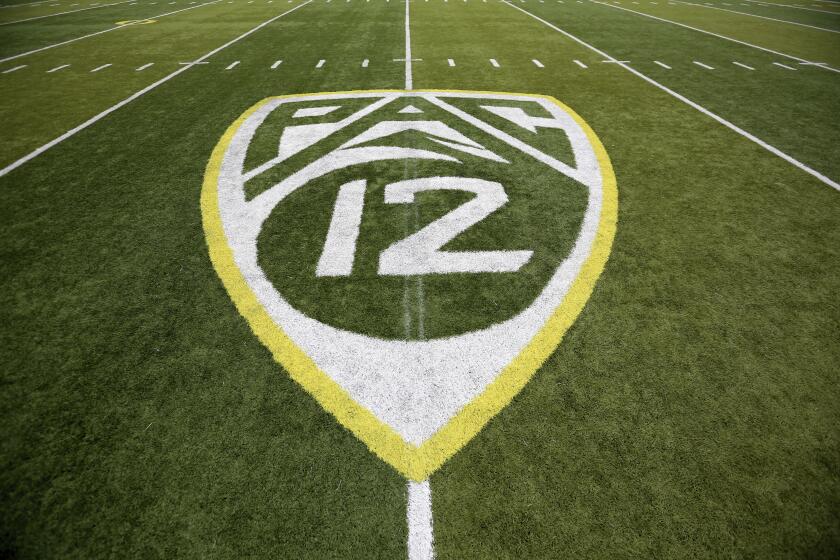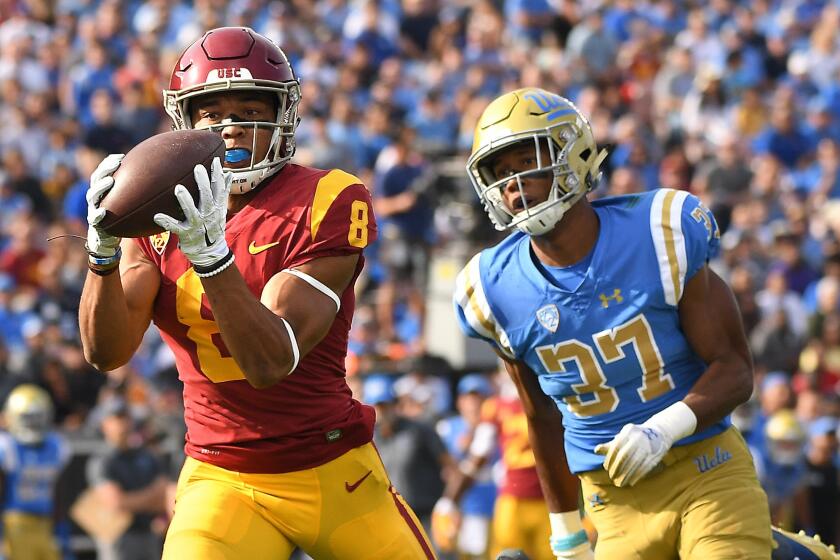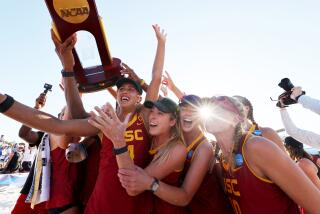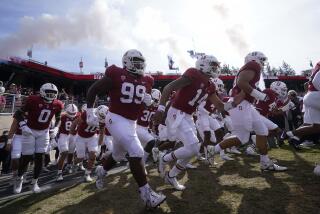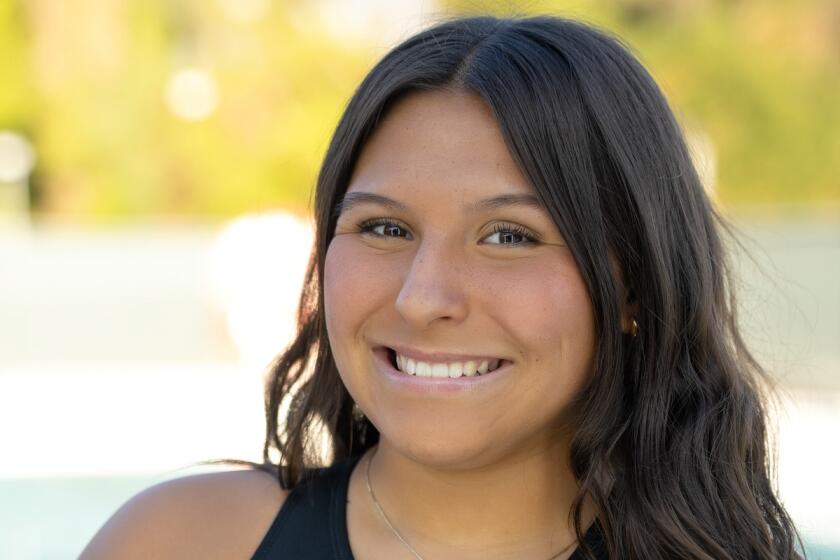Commentary: Pac-12’s pause on football decision buys it time to consider public health
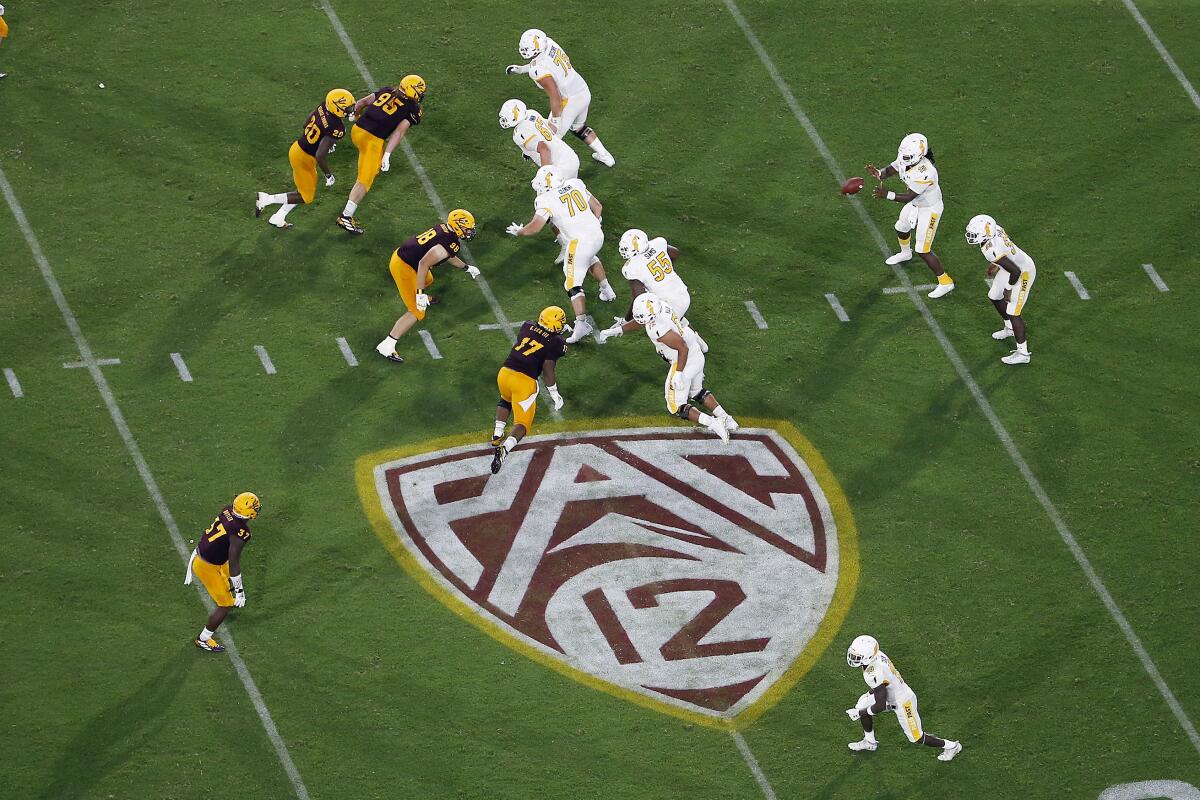
- Share via
As a tidal wave of momentum crested toward a Pac-12 fall football restart Wednesday, with athletic directors from USC and UCLA combining forces to push aside county regulations that had kept their teams from contact, a voice of reason came from Los Angeles City Hall.
L.A. Mayor Eric Garcetti has been known to cheer on the Trojans and Bruins from the sideline — he once guest conducted the USC marching band at halftime — but he seemed to realize this was not the time to be rooting for any particular result.
“I would just say there’s a lot at risk,” Garcetti said. “If we’ve learned one lesson from this summer, don’t take one step forward and then think you can take two or three. If you figure out a safe way for the athletes to really stay contained and to really stay in a bubble and to really have those testing protocols, don’t start creeping fans into it. … We know that the spread can happen very quickly in the fall.”
There will be no bubbles created to play college football. The closest thing to that will be players living on campuses offering mostly virtual classes, which happens to be the case at USC and UCLA. Throw in the daily antigen testing that should be available for Pac-12 schools by month’s end, and we can more easily assume safety for the “amateurs” who are potentially putting their long-term health on the line for their school’s bottom line.
Pac-12 presidents and chancellors intend to meet Thursday to determine whether the football season will begin before Jan. 1.
Garcetti was right to express caution. For as much concern has been properly placed on players being at increased risk of contracting myocarditis, a heart inflammation, it would be irresponsible to forget that staging college football games — even with no fans in the stands — amounts to a public health issue.
The Big Ten, which began Wednesday’s whirlwind by announcing its return to the college football season, was willing to ignore that in the face of mounting public pressure from players, coaches, parents and politicians, including President Trump, who was eager to claim a win in Midwestern swing states.
The Pac-12 presidents and chancellors have not had to deal with any kind of a firestorm like that — and won’t have to, no matter how frustrated their diehard fans are with being the oddball Power Five league still clinging to any moral high ground. Given the way Wednesday went, the natural assumption was that the Pac-12’s CEO group would meet Friday and issue at minimum an all-clear to begin ramping up for a fall season with a start date to be determined. Instead, the league said it wasn’t ready to act, setting another meeting for Thursday.
It was almost as if these university presidents still were looking at the big picture of their decision. The United States’ COVID-19 death tally hit 200,000 on Saturday, and we’ve got schools like Louisiana State and Texas Tech admitting that a majority of their players have had the virus and therefore have been able to spread it to the community at large. This year in the South, you apparently need herd immunity to win, along with a strong run game, of course.
By waiting for daily testing capability, the Big Ten and Pac-12 should be able to avoid this kind of gross negligence. If leagues were going to play this fall, this was always how it should have been done. But the Pac-12 still has the opportunity to weigh its decision from a public health perspective.
USC’s Mike Bohn and UCLA’s Martin Jarmond hear from state and L.A. County health officials, who say they won’t prevent teams from holding full contact practices.
When college football games are on television on fall Saturdays, it sends a message that times have returned to normal. Fans in Big Ten country are going to gather in groups to watch, let their guards down by putting away their masks, scream and hug in indoor spaces when something good happens, and the virus will receive new life all over the region. All so that Ohio State can get its crack at the College Football Playoff.
“Now we get to play for all the marbles,” Ohio State President Kristina Johnson said.
The schools don’t face liability problems for what their alums and fans do in their households, so that wasn’t a threat to the Big Ten CEOs.
California finally is making headway in its fight against COVID-19, with hospitalizations going down and the positivity rate near 3%. If we’ve learned from the reopening mistakes of the summer, officials will remain diligent until the numbers look like they do in the Northeast.
It’s not that the Pac-12 playing football starting around Halloween necessarily would change that trajectory. It’s more about the message it would send to a region being hit by a once-in-a-century pandemic and the worst wildfire season on record — the message that everything’s OK as a society.
The Pac-12 presidents are likely to follow the Big Ten once again, and it won’t be a surprise. America’s biggest universities, compromised by financial desperation and not wanting to dip into their endowments, no longer can be counted upon to act like leaders in the public discourse.
More to Read
Go beyond the scoreboard
Get the latest on L.A.'s teams in the daily Sports Report newsletter.
You may occasionally receive promotional content from the Los Angeles Times.

